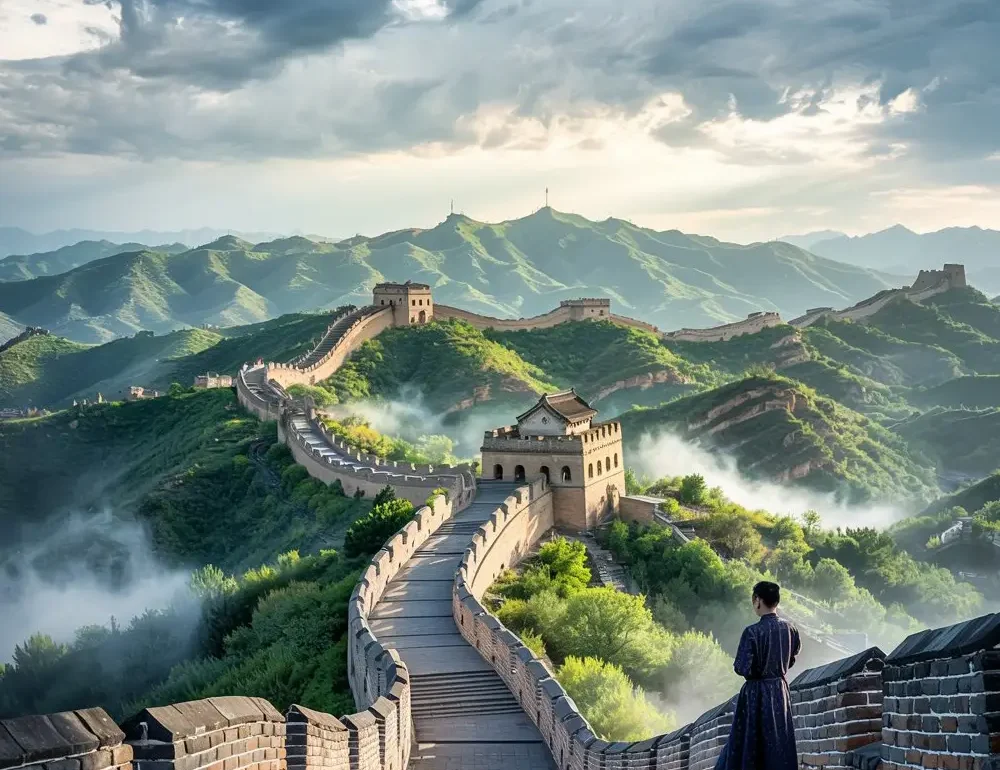The Great Wall of China: History & Mystery
- April 21, 2025
- 0
Introduction It’s not just a wall. It’s a legend. A bruised, ancient scar across China’s face. And yet—somehow—it stands. Great Wall of China. Spanning thousands of miles and

It’s not just a wall. It’s a legend. A bruised, ancient scar across China’s face. And yet—somehow—it stands. Great Wall of China.
Spanning thousands of miles and reaching through centuries of history, the Great Wall of China stands as a powerful reminder of human creativity, determination, and shared legacy. Bricks. Sweat. Bones, maybe. Every inch tells a story. And behind the stone? Secrets. Stories. A little bit of magic too. Great Wall of China.
Way before one China, there were many Chinas. Small states. Big problems. Constant war.
Each built their own walls. Not pretty. Not connected. Just… desperate lines in the dirt to keep invaders out. These were the roots. The beginning.
Then came Qin Shi Huang. First emperor. Big ambitions.
In 221 BCE, he slammed those scattered walls together. Unified them. Extended them. Why? Because the Xiongnu were a pain. And because power needs to be seen to be believed.
The Wall became a message: This is ours.
The Han took things further. They weren’t just about borders—they wanted business.
The Silk Road needed protection. So they added to the Wall. Built beacon towers. Smoke signals by day. Flames by night. Communication?Early. But brilliant.
The Wall existed before. Sure. But the Ming Dynasty made it iconic. Great Wall of China.
Thick. Tall. Fortified. Bricks replaced dirt. Stones replaced fear. What you see today? Mostly Ming handiwork.
They adapted. Mountains? They carved. Plains? They laid bricks like chessboards.
Used tamped earth, stones, and sometimes—rice mortar. Yep, sticky rice. Held better than you’d think.
Watchtowers everywhere. Over 25,000. Soldiers watched. Waited.
They had fire signals. Weapons caches. Even barracks hidden within the Wall. A giant, breathing defense machine.
It’s big. Like, really big. Great Wall of China.
Over 21,000 kilometers if you count every zig, zag, and branch. That’s half the planet’s girth. Let that sink in.
Not just walls. The Wall had depth.
Barracks for sleeping. Towers for spotting. Passes like Jiayu and Shanhaiguan were basically mini-castles. All of it part of a larger plan.
Imagine building with your bare hands… on a cliff.
Or in a desert. Or snowstorm. They did. No cranes. No tech. Just manpower. And a dream.
First and foremost—keep invaders out.
Especially the Mongols. Though, let’s be honest… it didn’t always work. Genghis Khan? He found a way around. Still, it slowed the others down.
The Wall screamed empire. It unified regions not just physically but symbolically.
A reminder: This is where China begins—and ends.
It also guarded trade. Silk. Spices. Knowledge.
And with all those beacon towers? Messages traveled faster than you’d think. A smoke signal could race across provinces in hours.
Sorry to burst the bubble. But no—you can’t see it from the Moon.
Astronauts tried. Didn’t work. It’s long, yes. But not wide enough. Still, the myth lives on.
They say the Wall’s haunted.
So many died building it. Men buried within. One tale speaks of Meng Jiangnu, whose tears brought a section down. Her husband died building it. Her grief? Unstoppable.
Some parts vanished—eaten by time.
Others, stolen brick by brick. People still whisper about secret tunnels, trapdoors, rooms behind stones. No one’s found them. Yet.
Millions worked. Not all by choice.
Soldiers, farmers, convicts. Anyone who could lift a tool. Or couldn’t resist conscription.
Heat. Cold. Landslides. Starvation.
They dropped where they worked. Bodies buried in the mortar. No records. No names. Just bones in the wall.
Some spots honor them. Quietly.
Villages nearby still pass down stories. Songs. Ghost rituals. They remember—when the world forgets.
In 1987, UNESCO stepped in.
Now it’s more than just China’s pride—it’s the world’s treasure.
Millions visit yearly. Selfies. Tours. Picnics.
But feet wear it down. Souvenirs chip it away. Some visitors take home pieces. Literally. That’s not okay.
It’s not just history. It’s identity.
Ask any Chinese person—this Wall means something. Strength. Unity. Endurance.
Wind and rain? They’re patient.
Bit by bit, the Wall crumbles. Especially in remote areas. Nobody’s watching.
Bricks stolen. Names carved. Parties thrown.
Even illegal roads cut through it. Preservation isn’t easy when the Wall is everywhere.
Fixing the Wall? A tightrope act.
Too much repair, and you ruin the past. Too little? And it disappears. The line’s thin.
Seen The Great Wall with Matt Damon? Not accurate. Still fun.
But dozens of real documentaries exist. Some deeply moving. Some just action-packed.
Photographers adore it. So do painters.
Each bend and tower—perfect framing. It inspires even beyond borders.
“Build a wall!” You’ve heard it before.
It’s become a metaphor worldwide. Mostly political. Sometimes poetic.
It’s not one wall. It’s many.
Some parts double back. Others dead-end. It’s like a maze more than a fence.
No uniformity.
Mountain sections used stone. Flatlands? Mostly dirt or bricks. They used what they had.
Did it work? Eh.
It stopped some. Not all. But it looked powerful—and sometimes that’s enough.
Badaling is popular. Crowded too.
Mutianyu? Prettier. More peaceful. Jinshanling? Rough. Great for hiking.
Shoes. Water. Layers. No flip-flops.
Also—stairs. Endless stairs. Train for it if you can.
Don’t take bricks. Don’t carve your name. Don,t be that tourist.
It’s ancient. Treat it like a living thing.
Drones now scan damage. AI maps threats.
It’s the future saving the past. Pretty poetic.
China’s working with UNESCO, historians, architects.
Global minds, one mission. Save the Wall.
This one’s hard.
How do you share a wonder with millions—without breaking it? That’s the Wall’s next great challenge.
The Great Wall is a line drawn in stone, across history.
It protected. It failed. It’s endured. still speaks—to those who listen.
A symbol of struggle, power, and imagination. It was built by hands, guided by dreams. And today? It still stands. A little bruised. A little broken. But utterly unforgettable.